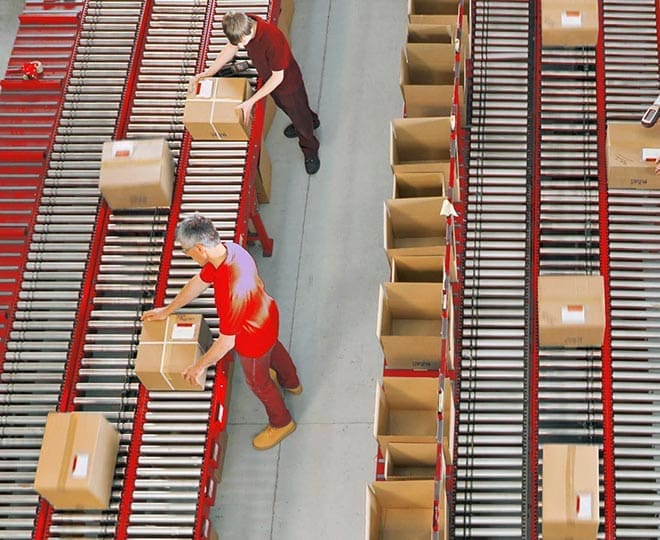Near where he lives in densely-populated New Jersey, Kevin Lawton sees something every time he goes anywhere: warehouses with “We’re Hiring” signs permanently set out front.
“It’s an extremely competitive labor market right now,” explains Kevin, who has been in warehousing for 13 years and now hosts the popular industry podcast The New Warehouse. “Especially for small and mid-market businesses, when bigger players are able to pay higher wages. I’ve seen employees jump ship for 50 cents more an hour.”
Data confirms Kevin’s experience. The Harvard Business Review reported on a survey of 2,000 supply chain executives. When asked their biggest challenge for the year, 57% of them said it was to hire and retain qualified workers.
Warehouse leaders need to find an edge in order to succeed in this labor market. That means not just paying higher wages, but also making jobs better. Technology and automation can do that — so long as those solutions are right-sized for your operation.
We sat down with Kevin to talk about the industry’s labor challenge and how embracing warehouse automation and technology can:
- Support consistent operational performance
- Improve efficiency
- Give you predictable capacity
- Reduce labor issues and stabilize hiring needs
- Create safer working conditions
- Allow you to attract and retain the best team members
- And reduce employee fatigue and burnout for long-term success
Read on for:
The 4 Facets of the Labor Challenge
1) Meeting high wages
2) Creating safer jobs
3) Motivating workers
4) Reducing labor needs
3 Tips for Maximizing the Positive Impact of Warehouse Automation on Your Workforce
1) Don’t go for the “shiny object” right away. Get your foundation right.
2) Listen to your team.
3) Look where automation can improve jobs outside of picking.
The 4 Facets of the Labor Challenge
1) Meeting high wages
In 2018, Kevin was running a manufacturing and distribution facility and paying his team $13.50/hour, which he says was a “very competitive” wage at the time. “At the end of the pandemic, two and a half years later, we were offering $20/hour just to get new hires in the door.”
That lines up with industry averages; in a 2023 WSJ article, a 3PL company said they paid warehouse workers $20-24/hour, compared to $14-18 pre-pandemic.
Even with higher wages, warehouse leaders have struggled to hire. Kevin shares an example: in the holiday season, he usually had access to 1,800 temporary workers for extra shifts. In recent years, only 800 were interested.
He found that workers didn’t just want to be paid well — they wanted more flexible, safer work. “The pandemic pushed forward the idea of more flexible working situations. But in the warehouse, there’s not much flexibility. You can’t pick and pack orders from home,” says Kevin.
2) Creating safer jobs
It’s true that you can’t pick and pack warehouse orders from home, but technology can go a long way in creating safer, easier work in the warehouse.
A report of Amazon warehouses in the Chicago area found that they had injury rates up to four times higher than average.
Lee Freidman, co-director for the Illinois Injury Prevention Center and professor of occupational health science at University of Illinois Chicago’s School of Public Health, attributed that higher rate of industries to two things: increasing customer expectations for 24-hour delivery and constant cycling through temporary employees.
The right technology can move orders along quickly and allow you to hire long-term, permanent employees who know your systems and can work safely.
“Someone who is loading and unloading containers by hand isn’t not going to stick around for a long time,” says Kevin.
Safer jobs can mean investments as small as improving the user interface on handheld picking devices, says Kevin, or as large as automating container unloading with robotic solutions.
“Taking away the dull, dirty, and dangerous tasks helps keep new employees in the door,” he adds.
3) Motivating workers
Technology can improve efficiency and safety and reduce human error. It can also make employees feel more motivated to show up to work and do their jobs excellently.
“Think about your smartphone. If you download an app that isn’t user-friendly, you delete it. There’s no reason that can’t be the case with systems in the warehouse environment,” says Kevin. “The key is to create a better work environment through technology.”
He gives examples: more intuitive interfaces on handheld devices, touch screens on computers, and easy-to-follow instructions and metrics at pack stations. “On a legacy system, you have to remember what F5 does. Now it tells you exactly what to do. That makes a difference in the quality of work and decreases training time.”
4) Reducing labor needs
Making jobs better goes a long way in solving the supply chain’s labor challenges — but it won’t solve them completely. Per the U.S. Chamber of Commerce, there simply aren’t enough workers. “Even if every unemployed person with experience in the durable goods manufacturing industry were employed, the industry would fill only around 75% of the vacant jobs,” quotes HBR.
Technology can help fill the gap. Make the biggest impact on labor shortages with smart investments in warehouse automation, including:
- Automating warehouse jobs that see the most employee turnover
- Adding technology in specific parts of time-consuming manual processes, like AS/RS for unloading and storing goods or automated packaging machines for labeling and taping shipments
3 Tips for Maximizing the Positive Impact of Warehouse Automation on Your Workforce
1) Don’t go for the “shiny object” right away. Get your foundation right.
“A lot of marketing around warehouse technology is about robotics. It’s the shiny object. At trade shows and conferences, that’s catching everyone’s attention. But there’s a lot an operation can do before they even get to the idea of entertaining robotics,” says Kevin.
He suggests starting by optimizing existing processes, which is also how ISD approaches every warehouse automation project.
“If you’re automating a process that’s not optimized yet, you’re just making the bad parts of that process go faster, which is not a benefit, and you’re not going to get the ROI you’re expecting,” advises Kevin.
Doing this might mean adding:
- Software to improve digital interfaces and controls for workers
- Devices like conveyors to streamline manual processes
- Other hardware or software customized to optimize your space
“Dialing in on your processes first creates a strong foundation. Then you can take a bigger jump into automation or robotics,” says Kevin.
2) Listen to your team.
The best way to improve profitability in your warehouse, long before you spend a lot of money adding technology or automation to your warehouse, is to start with data, urges Kevin.
“You want to compile data points and feedback and look where you’re doing well and where you’re not,” he explains. “Then you can address and adjust.”
He suggests looking at hard data as well as interviewing people on the floor. ISD agrees. We start every project by analyzing the specifics of your warehouse and listening to the people who work there.
When reviewing your warehouse’s metrics, look for:
- Your highest-traffic pick areas and where there is congestion in your warehouse
- Your velocity of picks and highest-moving SKUs
- Your speed of picks and when (times of day, point in shift) where workers are most and least productive
For interviews with people who work in your warehouse, try these questions:
- What are your pain points?
- What don’t you understand about our processes, or our system?
- If you go back and forth between different departments or tasks, which job is worse, and why?
Kevin gives an example: “An employee is using a pick cart, pushing that around for 7 hours a day and picking heavy items. The data is going to show a drop off in productivity at the end of the shift, which makes sense because they’re working out all day long. The employee might say they’re fatigued. In that case, an AMR (autonomous mobile robot) could come in and take away some of the heavy lifting.”
3) Look where automation can improve jobs outside of picking.
“There’s been a lot of focus on how automation can help with picking,” says Kevin. “But what’s exciting to me is how other processes are getting more attention. One that really stands out is trailer container loading and unloading.”
Unloading containers requires workers to be in extreme conditions — freezing in winter, boiling in summer. UPS drivers, who load and unload much smaller delivery trucks, were prepared to strike last summer over the extreme heat and unsafe working conditions they faced.
ISD has installed automatic truck loading and unloading solutions for warehouses all over the country. The warehouse of the future needs to solve labor challenges across its work stream, and we’re experts at getting the most out of technology everywhere in the warehouse, from receiving to storing to picking to shipping.
Embracing Automation
From the United States to China, countries are experiencing worker shortages. Generations are smaller, competition from other industries is high, and almost every company in warehousing or manufacturing is facing reduced labor availability.
But per the World Economic Forum, “automation can amplify the workforce.” By speeding up warehouses’ manual processes, shortening training time, and creating better jobs for workers that remain, warehouse automation will increase productivity — and actually create more, better jobs for the future. The WEF estimates that by 2025, technologies including warehouse automation software and hardware will create 12 million more jobs than they eliminate.
There is a warehouse automation solution that is right for you, and ISD will work hard to engineer it. We are true partners to our customers, right-sizing every project to the specific needs of your operation. We’ll tell you what makes sense, and what doesn’t, for your goals and budget, without getting distracted by shiny objects or trends.
We partner with warehouses to grow towards their future.
Ready to get started? Reach out for a free consultation today.






